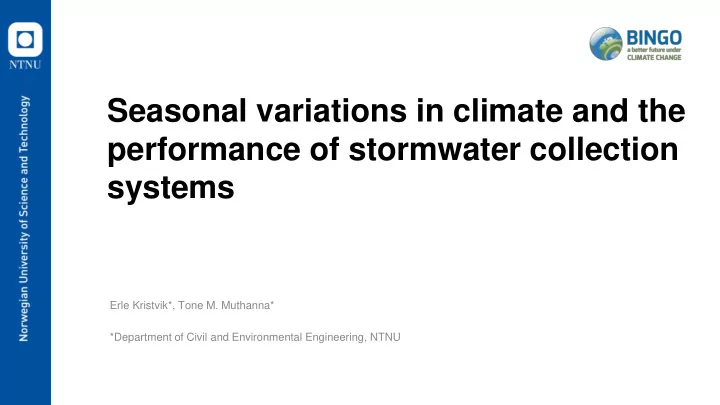

Seasonal variations in climate and the performance of stormwater collection systems Erle Kristvik*, Tone M. Muthanna* *Department of Civil and Environmental Engineering, NTNU
B ringing IN novation to on GO ing Water Management www.projectbingo.eu Funded by Horizon 2020 Coordinated by LNEC - Portugal Providing practical knowledge and tools to end users, water managers and decision- WP1 Coordination makers to better cope with all climate projections, including droughts and floods. BINGO WP2 Norway Bergen Research Sites Climate predictions The and downscaling Netherlands WP3 The Veluwe Analysis of the water cycle Germany WP4 Wupper River Basin Impacts of extreme weather events WP5 Portugal Risk treatment Tagus and adaptation WP6 strategies Excellence and actionable Spain Badalona research WP7 Cyprus Dissemination Troodos Mountains and exploitation The BINGO project has received funding from the European Union's Horizon 2020 Research and Innovation programme, under the Grant Agreement number 641739.
Study site • • Damsgård Pronounced topography • • Residential area in the city of Bergen, Runoff from mountainous area entering Norway residential area • • Prioritized transition of area Combined sewer system 3
Blue-green and open solutions • Conflicting policies • Retention capacity varies with differences in temperature and precipitation • Across locations • Between seasons 4
Application of climate data Kleiven et. al (2017)* *Kleiven, G. H., Kristvik, E., Muthanna, T. M., Lohne, J. (2017). Local Climate Projections And Their Implications For Raingardens In Bergen. 5 Poster presented at the Embrace the water (ETW) conference, Gothenborg, Sweden, 2017.
Climate indices Name Index for Equation Explanation Total precipitation in wet- RRij is the daily precipitation amount on 𝑄𝑆𝐷𝑄𝑈𝑃𝑈 𝑘 = 𝑆𝑆 𝑗𝑘 PRCPTOT days day i in period j 𝑆𝑦1𝑒𝑏𝑧 𝑘 = max(𝑆𝑆 𝑗𝑘 ) RRij is the daily precipitation amount on Rx1day Maximum 1-day PRCP day i in period j Maximum consecutive 5-day 𝑆𝑦5𝑒𝑏𝑧 𝑘 = max(𝑆𝑆 𝑙𝑘 ) RRkj is the precipitation amount for the Rx5day PRCP 5-day interval ending k, period j RRwj is the daily precipitation amount 𝑋 Annual total PRCP when 𝑆95𝑞 𝑘 = 𝑆𝑆 𝑥𝑘 𝑥ℎ𝑓𝑠𝑓 𝑆𝑆 𝑥𝑘 on a wet day w in period j, and RRwn95 R95pTOT is the 95 th percentile of precipitation on RR>95p 𝑥=1 = 𝑆𝑆 𝑥𝑜 95 wet days in the 1961-1990 period RRwj is the daily precipitation amount 𝑋 Annual total PRCP when on a wet day w in period j, and RRwn99 𝑆99𝑞 𝑘 = 𝑆𝑆 𝑥𝑘 𝑥ℎ𝑓𝑠𝑓 𝑆𝑆 𝑥𝑘 R99pTOT is the 99 th percentile of precipitation on RR>99p 𝑥=1 = 𝑆𝑆 𝑥𝑜 99 wet days in the 1961-1990 period http://etccdi.pacificclimate.org/list_27_indices.shtml (Karl et al. 1999; Peterson Folland, C., Gruza, G., Hogg, W., Mokssit, A., Plummer, N. 2001) 6
Observed seasonality • Rx1day • Rx5day • R20mm DJF = Winter JJA = Summer MAM = Spring SON = Fall 7
Observed seasonality Rx1day Q90 Q99 Rtot Mu Fw DJF 80.1 19 43.2 1093.6 11.9 0.54 MAM 67.1 12.8 36.2 763.5 9.0 0.45 JJA 71.8 16.2 41.9 847.1 11.0 0.45 SON 121.2 27 55.5 1371.4 14.6 0.62 ANNUAL 121.2 19 44.9 3210.2 12.0 0.52 Mu = wet-day mean Fw = wet-day frequency 8
Observed seasonality 9
Long-term projections • R package ‘ esd ’ • Methodology proposed by Benestad and Mezghani (2015)* • Empirical-statistical statistical downscaling of: – Wet-day mean, Mu Parameters of the – Wet-day frequency, Fw exponential distribution • Predictor: Temperature / saturation evaporation pressure • Calibration with data from NCEP/NCAR reanalysis • Projections of 19 GCMs *Benestad , R. E. and Mezghani, A. (2015) ‘On downscaling probabilities for heavy 24 -hour precipitation events at seasonal-to-decadal scal es’, Tellus, Series A: Dynamic Meteorology and Oceanography , 67(1), pp. 1 – 20. doi: 10.3402/tellusa.v67.25954. 10
Results • Best fit obtained for the wet-day mean, Mu Mu Fw 11
Results 12
Projected seasonality Mu Fw Present 1 +11% -4% 11.9 0.54 DJF Future 2 13,2 0.52 +24% +4% 9.0 0.45 MAM 11.2 0.47 +7% +7% 11.0 0.45 JJA 11.8 0.48 +8% -6% 14,6 0.62 SON 15,8 0.58 1 Present: 1961-1990 2 Future: 2071-2100 13
Projected seasonality Rx1Day Q99 Present 1 +41% 43 DJF 80 Future 2 61 +43% 36 MAM 67 52 +30% 42 JJA 72 54 +31% 56 SON 121 73 1 Present: 1961-1990 2 Future: 2071-2100 14
Discussion • Climate indices as indicators for stormwater • Assumption: exponential distribution • Downscaling of Mu and Fw • What is ‘good enough’? 15
Further work • Projections for temperature • Implications for blue-green infrastructure Thank you! 16
Recommend
More recommend